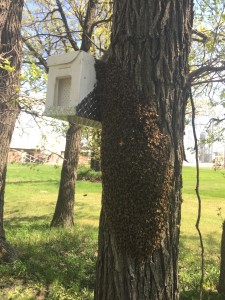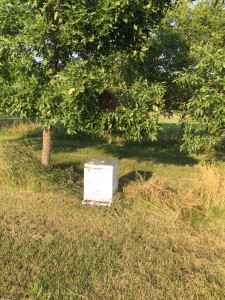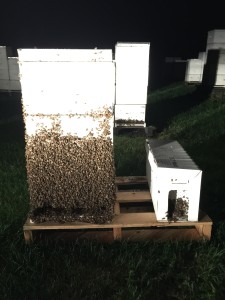Swarms
About Swarms

‘A swarm in May is worth a load of hay; a swarm in June is worth a silver spoon; but a swarm in July is not worth a fly.’ Proverbial bee-keepers’ saying, mid 17th century. This saying makes reference to the worth of a swarm with its potential to collect honey that calendar year.
Swarming is a natural part of beekeeping that often creates a buzz. Many curious onlookers are filled with wonder at this natural phenomena. We want to share how we prevent, capture and care for swarms each year.
Why Bees Swarm
If you consider the entire hive acting like a single organism, then swarming is a natural way of organism reproduction. Swarming occurs when a hive becomes overpopulated with bees, or has simply run out of room for nectar storage. Some genetics tend to swarm more than others and aren’t preferred. Bees love work, and if they can’t due to limited hive space, they will swarm.
When swarming instinct kicks in, swarm cells are created. They are easily identified on the bottom of frames. However, the beekeeper must use judgenemnt as not all queen cells on the bottom of frames are swarm cells. The condition of the hive must be examined before that judgement call. Just before the new queen hatches, the old queen will leave the hive and approximately half the hive will go along with her.
The new queen exits the hive and finds a temporary landing spot where bees cluster around her. This can be a tree branch, pole, bike, or any other surface they can cluster. While the swarm clusters there, scout bees will fly away to look for a more permanent lodging. So when you spot a swarm, it’s best to call a local beekeeper as soon as possible because they might move on. Swarms that cluster in the open are usually not dangerous because they have little to protect. No larvae and no honey has been gathered. Sometimes people even stick their hands into the cluster with little effect from the bees.
If the swarm isn’t captured in the temporary location, they will fly to a more secure location. When they are more established, they can be a lot more difficult to rescue. At that point they may need to be cut out of the wall or floor.
I often get asked, ‘Do you know where they come from?’ Many times I can look at a bee yard and look at the amount of bees coming and going from a hive. Sometimes, you will notice that a productive hive simply doesn’t have the population anymore. That is usually a good indicator that it may be your original swarm hive. I never merge aswarms back to the hive.

Swarm traps
I set up swarm traps at the Apiaries. A swarm trap is simply a nuc or an old box with frames inside. They are elevated 6 -10 feet in the air. This makes it a perfect place for new swarms. A swarm lure can be placed inside the hive to attract scout bees.
A simple method for luring the swarm is to take a kleenex and put 4 drops of lemongrass essential oil on it. Put it inside a zip lock bag. Seal the zip lock bag but leave a small crack unsealed so the smell can waft out of the bag. This will lure potential swarms inside your trap and requires less work ‘catching’ a swarm.
Be sure to place the trap at an easily accessible location.
Swarm Prevention
Every beekeeper is responsible to mitigate and prevent swarms to happen. Despite your best efforts, they will still occur.
Even though a swarm helps with increased hive numbers, it’s best to prevent swarms and potential PR issues they can create. The original hive can be severely downgraded to the point where it may take the rest of the year to recover. Swarmed hives will not produce an abundance of honey and the swarm will likely take time to get established. The time of year the swarm occurs is the critical factor in determining how much they can produce.
The best prevention is to control your hive size. If a hive gets too large, take 2-3 frames of brood and make up a new nuc with the frames or give them to another weaker hive. This is a great idea for spring bee management. If this is done, you can prevent most of the swarming in your bee yards.
Another method is to stay ahead of supering. When a box is half full of bees, you should add another one. Just prior to honey flow, we add two deep supers to all hives in anticipation of the heavy flow.
Inspections are another key part of swarm prevention. During swarm season (June – August) in my location, hives should be checked for swarm cells. We rarely take down an entire hive filled with honey to check for cells, but you can do it easily just after you take off honey supers. You might be surprised how many hives are in the process of swarming or superceding.

Catching a Swarm
When we find a swarm, and we usually have several each year, we take a nuc or a regular hive box (pending on size of the swarm) and remove some frames in the middle. We place it under the swarm on a ladder (if you can reach it) and then give the branch or object a quick shake. Most of the cluster should fall into the box and we close the lid immediately. If the swarm is one a surface that cannot be shaken, you can use a bee brush to gently brush them into the box.
The only bee you technically need inside the box is the queen. If the queen falls into the box, the other bees will follow shortly after. Sometimes 2 or more shakes will be required because the queen doesn’t land in the hive box and she flies back on the cluster surface.
When we’ve been lucky, we’ve found the queen crawling around outside the hive box. We simply take her and put her in the hive. A swarm queen is usually a good quality queen because she lay enough eggs to outgrow her hive. Unless they are swarmy, I usually keep swarm queens.
When you notice the bees start entering the box, you know you’ve captured the queen. You can then place the hive on the ground or near the swarm location so the other bees will find the new entrance. We wait until sunset and then move the hive to a new location. The bees’ GPS is reset when in swarm mode so you can place the hive back in the original apiary and the bees will reorient to the new location.

After Catching a Swarm
A captured swarm is like a new hive with no resources. When you’ve moved the swarm to the new location, always add a frame of brood to the hive as soon as you can. I also add a pollen patty and sugar water. If you don’t add brood, the swarm might abandon the hive again. Brood is like a ‘welcome home’ present and gets them going in the right direction very quickly.
After you have given them brood, patty and feed, leave them alone for at least a week because the queen should be allowed to establish her brood pattern.
It is also possible to catch a swarm with a virgin queen. These are usually ‘afterswarm’ bees and they can be put into a nuc or queen castle pending on the size of the swarm. I usually give good looking virgin queens an opportunity to become mated because an extra queen on hand is always nice. Sometimes these ‘afterswarm’ clusters are very small.
Conclusion
Even though I do my best to prevent swarms, they are a reality in the beekeeping world. If you see one, get it as soon as possible and you’ll have another hive free of charge! Continue to monitor the new swarm and the original hive if you can find it. The original hive has a new queen and she needs to mate before she can be productive. If you have an opportunity to educate others around you about swarms, take the time to do so, it may pay off in the longterm.